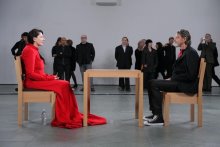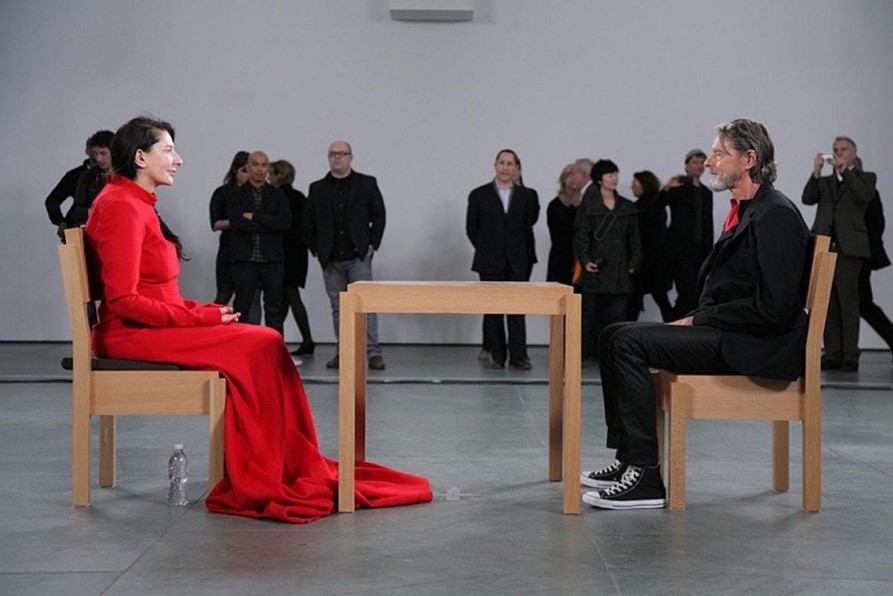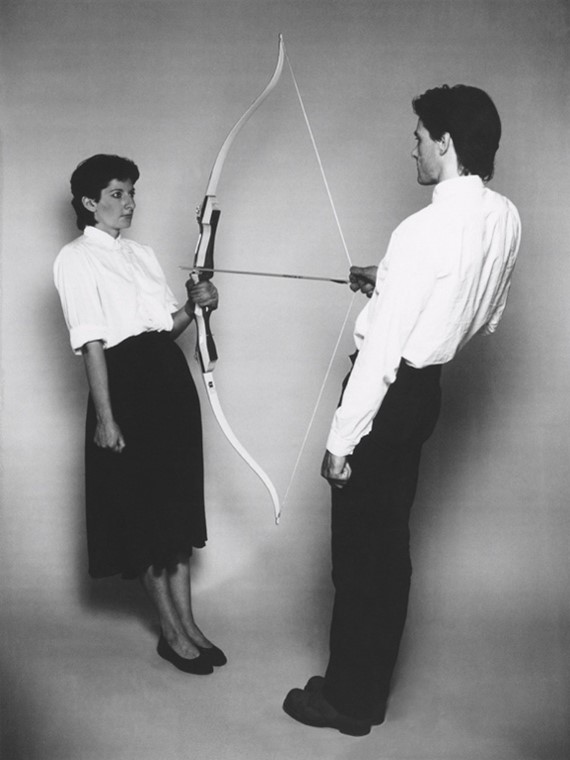






Exhibition review by Rose, Year 13, Art History A Level
Earlier this term, Sixth Form Art and Art History students visited the Marina Abramovic Exhibition at the Royal Academy of Art (the exhibition runs until January 1st). In her review of the exhibition, Rose delivers her insights into the artwork of this pioneering artist.
Marina Abramovic’s groundbreaking exhibition at the Royal Academy of Arts happens to be the first solo show by a woman in the RA’s main galleries in its 255 years of existence, and it successfully exceeds these weighty expectations. After the retrospective was postponed from 2020-2023, Abramovic claims the show is “absolutely not a retrospective because we decided that my old work has to have a conversation with the new work, and it does.” The exhibition journeys through her extensive explorations of physical and mental endurance and autonomous depiction of pain and trauma while using her body as both the media and stimulus in her performances. This sentiment is reflected by the Tate, where “trauma is presented as a form of sculptural language”. Abramovic wields the language of her communist Balkan roots and her rise to fame in the growing feminist movement of the 70s to explore and rebel against her spiritual and gendered constraints and project the ‘dialogue of energy’ between the audience and artist during the cathartic performances. The key concerns in her work are duration, risk-taking, testing the physical and psychological endurance of the body, abjection and theatricality, and the existence of violence in a misogynistic society – being a woman her rebellious performances have a particular resonance within the canon of art history and the previously male-dominated movements of Minimalism, Surrealism and Pop art.
Abramovic was born in the former Yugoslavia in 1946 and began her life in the aftermath of the Second World War amid the beginnings of Tito’s communist rule, to parents employed in his government. At 8 months she was taken to live with her maternal grandmother, Milicia Rosic who was strongly religious, which had a deep impact on the young Abramovic, while later fostering her interest in Buddhism, shamanism and meditation, which transcended into her art as a vehicle for emotional and spiritual transformation. In 1973 Abramovic performed her first performance “Rhythm 10”, where she continually stabbed a knife between the splayed fingers of one hand, recording and repeating the pain-ridden mistakes, which she later described as ‘the moment that I knew I had found my medium’. Following this performance, in 1975 she met Ulay, not only her life partner but her artistic soulmate, who she spent the next 15 years creating work with. Through their work they felt a confluence of their energies creating a third existence they named the ‘That self’, which became the basis for many other performances such as “Rest Energy” (1980).
We are transported into “The Artist is present” (2010, MoMA, New York) in the first room of the exhibition where the audience members’ expressions are depicted on one wall and on the opposite wall is Abramovic’s journey from dispassionate to drowsy to that of utter exhaustion. This places the viewers in an omnipresent, overlooking position and makes one feel as if they’re a new, third perspective experiencing the performance for the first time. This later work of Abramovic explores the realm of meditation and the quasi-spiritual exchange of energy she believes is vital for any work of durational art. I believe it was a considered yet bold curatorial choice to display one of her most astounding performances in the first room, in order to captivate the audience from the get-go, with 850,000 visitors seeing the work, lasting 8 hours a day for nearly 3 months, or a total of 512 hours. The curatorial decision also reflects Abramovic’s wishes she expressed in a recent interview with Sinéad Gleeson, “I feel a responsibility to put performance art, as the most transformative form of art, into the mainstream.”

Her most renowned work “Rhythm 0” (Naples, 1974) is displayed in the adjoining room, creating a stark contrast with her earlier passive works exploring the violence of a misogynistic society and reminds the audience of the harsh reality and risks around Abramovic surrendering her power to the audience. This was a six-hour performance at Galleria Studio Morra in Naples during which Abramović allowed herself to be manipulated by the public in any way they chose, using a range of 72 objects laid on a table, such as grooming tools, food and weapons. Despite seemingly being passive and vulnerable while depicting the female nude, in using her own body she reflects ownership and empowerment through a radical artistic medium never used by men. The performance confronts the audience with their actions while amplifying their voyeurism and again makes them question the role she plays - is she the victim, is she vulnerable or is she the puppet master? I believe even in her vulnerability she is the puppet master yet she journeys from power to powerlessness and then regains this power as a creator as the artwork becomes a documented moment in art history. As Sally O’Reilly puts it, “The artist has spoken since of the ease with which she became dehumanised”, where her “body became a temporarily inert ‘thing’ in what proved to be a bold social experiment.”
.jpg)
“Rest Energy” (1980) was a 4-minute performance in which Ulay holds an outstretched bow and arrow in front of Abramovic, while she holds the frame of the bow. Both participants lean back in an act of trust, and each one had small microphones on their hearts where they would hear how as the performance progressed, their heartbeats became more intense, and Abramovic stated that this was one of her most terrifying performances, yet she reflected that “I only do something if I’m afraid of it, because that’s the whole point.”, and that in partaking in what makes us scared or uncomfortable, we discover unchartered territory.

Overall, I found Abramovic’s retrospective fundamentally inspiring and confirmed her wish to immortalise her works through other performers, particularly as the first female solo exhibition in the RA. However I also think that in the act of not performing them herself, the works also lose some of their original poignancy and rebellion, and Art critic Laura Cummings expresses how “the performance art pioneer’s blockbuster 50-year retrospective underlines her bravery, yet sells it short with off-key re-enactments by stand-ins”, which I believe confirms the dichotomy between successfully representing Abramovic and the question of autonomy and ownership when her intrinsically personal works are performed by others.
Resources:
Sally O’Reilly article: https://www.royalacademy.org.uk/article/marina-abramovic-three-of-the-best
Laura Cumming review: https://www.theguardian.com/artanddesign/2023/sep/24/marina-abramovic-royal-academy-london-50-year-retrospective-review-the-artist-is-strangely-absent
#AlleynsArtHistory
